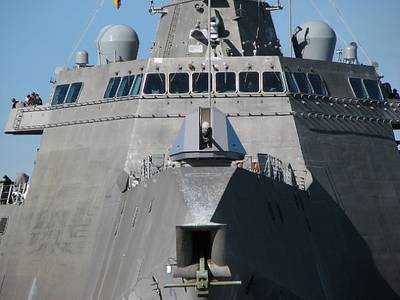Quest for More Lethal U.S. Warship Could Raise Cost
By Andrea Shalal, Reuters
Defense Secretary Chuck Hagel's decision to stop building the current class of coastal warships after 32 vessels and focus on ships with more firepower and protection will result in higher costs, U.S. defense officials said on Monday.
Hagel announced the decision during a preview of the Pentagon's fiscal 2015 budget proposal, saying that growing threats in the Asia-Pacific region in particular meant the Navy needed to develop new small surface ships that could operate "in every region and along the full spectrum of conflict."
Hagel said that given the new threats, he had "considerable reservations" about building all 52 coastal warships as planned, which would account for one-sixth of the future 300-ship Navy.
"I recognize the importance of presence, which is tied to the number of ships. But I also believe that capability and power projection is the foundation of our Navy's effectiveness," he said in a memo to top Navy leaders.
Hagel told Navy Secretary Ray Mabus and Chief of Naval Operations Admiral Jonathan Greenert to study alternative proposals for a new "capable and lethal small surface combatant, generally consistent with the capabilities of a frigate" in time to inform the fiscal 2016 budget negotiations.
The options should include a completely new design; existing ship designs, including the current coastal Littoral Combat Ships (LCS); and a modified LCS ship; factoring in cost, mission and weapons requirements, sensors and required delivery date, Hagel said in a memo, a copy of which was obtained by Reuters.
Lockheed Martin Corp and Australia's Austal Ltd are building two different models of the Littoral Combat Ship, which were designed with modular, interchangeable equipment packages that can be swapped out to hunt for mines, fight submarines, or engage in surface warfare.
The first versions of the ships have run into a variety of technical issues during initial deployments and testing, but Navy officials say they are generally pleased with the overall performance of the ships.
The two companies are each under contract to build 10 of the ships, in addition to four others already built, for a total of 24 ships. Hagel said he wanted to buy an additional eight LCS ships before halting the program, but did not explain how those ships were to be divided between the two companies.
Bryan Clark, a former aide to Greenert and senior fellow at the Center for Strategic and Budgetary Assessments, said the Navy was likely to award each of the companies a contract for four more ships, which would keep costs low and maintain the industrial base until a new program could get started.
If the Navy opted to use a modified LCS as the follow-on ship, Hagel said, he expected any contracts beyond the current 24 ships to adopt those changes as soon as possible.
He also asked Navy officials to assess the performance of the current ships, examining a range of factors including operating costs, survivability, lethality and growth potential. He said he could opt to modify the program if those assessments prove unsatisfactory, but gave no further details.
Clark said it would cost about $600 million in today's dollars to build a Perry-class frigate, compared to around $500 million for one of the current LCS ships combined with one or two mission packages, which are priced separately. He said the first ship in the class would likely cost around $100 million more, given the non-recurring cost of design work.
"It's clear that a new ship program will cost more," agreed one defense official who was not authorized to speak publicly, adding that the extent of the additional cost would depend on the Navy's review of possible alternatives.
The comment came from one of four defense official who confirmed Pentagon's new approach would result in higher costs in coming years.
Clark said Hagel's approach would help the Navy achieve its goals for the mine-hunting and anti-submarine warfare missions, while bridging to a new more lethal and survivable ship.
Defense officials said Hagel's change in direction for the small surface warships was not that different from work on the current generation of destroyers, which also evolved over time, and the Navy was already undertaking testing and modifications.
"This is exactly what we did with the destroyers," said one official, who was not authorized to speak publicly. "It was clear from the start that the 32nd LCS ship would be different from the first one."














